Basic Principles of Classical Ballet (16 page)
Read Basic Principles of Classical Ballet Online
Authors: Agrippina Vaganova

60. Jeté passé (front)
Jeté passé back is done in the same manner, i.e. stand at the beginning croisé, left foot front, change onto the left foot in 4th position effacé back, in demi-plié, bend body to that leg; both arms open into 2nd position with open palms, keeping the shoulders level. Squat on left foot, thrust right one high forward and with a jump place it on the spot of the left one, then, throwing the left leg to 90°, forward in croisé, assume required pose, i.e. the body and the head may be turned right or left corresponding to the turn of the body.
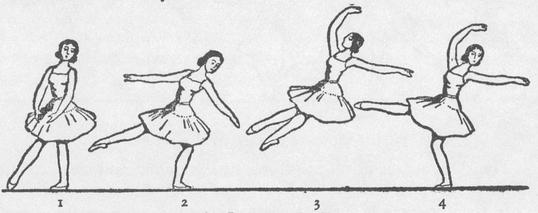
61. Jeté passé (back)
JETÉ RENVERSÉ
From demi-plié in 5th position throw the leg with a grand battement into 2nd position at 90°, open arms in 2nd position, palms down; jump onto the raised foot into attitude croisée stopping in it in plié and do renversé en dehors, finishing it in 5th position.
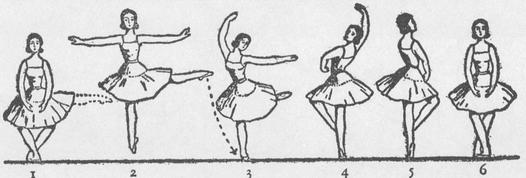
62. Jeté renversé en dehors
The same movement can be done backward, i.e. after one of the legs is thrown into 2nd position, bring the other one, after the jump, forward at 90° in croisé and do renversé en dedans.
See to it that the jump is finished croisé and that renversé is done correctly, i.e. that this is not done with the back to the audience. This will happen if the back is turned too soon while jumping in attitude, or in the reverse pose développé forward, mentioned above.
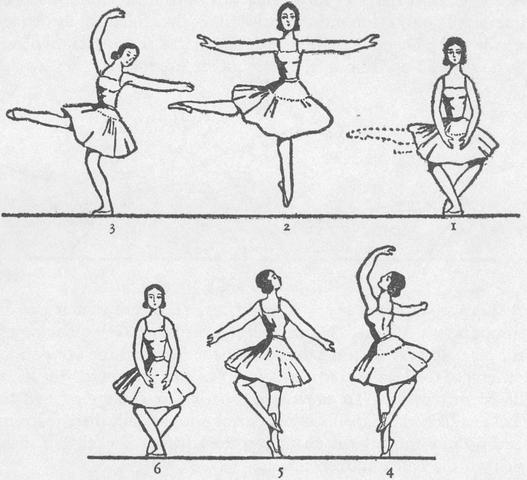
63. Jeté renversé en dedans
In this movement one should not rise on half-toe after the jeté, but one should join it to the following renversé, through pas de bourrée, i.e. step on the other foot on half-toe and conclude renversé.
JETÉ ENTRELACÉ
We begin to study this step moving from the right front corner of the classroom diagonally to left back corner, so as to face the audience all the time. This way it is easier to understand the step. Later on the step can be done moving from the back diagonally to the front. In this case all stops will be with the back to the audience.
Stand in pose effacé back, right foot forward, demi-plié, left leg is raised to 45°, body bends forward, left arm is forward, as in the 2nd arabesque. Open arms into 2nd position, change into demi-plié on the left leg; with a wide step diagonally back push off the left foot, thrusting the right leg to 90° forward to point 6 and, joining the arms in 1st position, jump on to the right leg, turning to the left. During the jumps the legs appear to interlace (this is the reason for calling this movement entrelacé, i.e. interlaced), only at this moment turn the body a full turn, throwing up the arms; i.e. hold the body en face, so that the turn takes place during the jump. Finish in arabesque or in attitude.
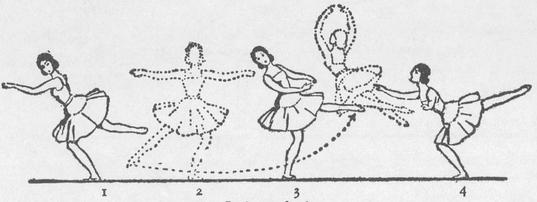
64. Jeté entrelacé
When you throw over the right leg, take care that it passes through 1st position. This will help to preserve the interlacing of the legs; also try to come down after the jump on the same spot, otherwise the legs pass too widely open, and the movement loses its correct design. To prevent the body from dragging and to make it help the movement, the arms should gain their force in 2nd position during the change to the left foot. In this lies their help to the entire movement.
JETÉ EN TOURNANT PAR TERRE
This jeté is called par terre because its direction is not into the air but horizontal.
As an example, let us take jeté en tournant par terre which progresses diagonally from the left back corner of the classroom to its right front corner.
Stand in 5th position, right foot front, demi-plié; diagonally in the direction of effacé throw out right foot with a gliding movement on the floor, fall on it in plié, pushing off with the left foot. The right arm in the same direction, the left one—to the side in the 2nd position.
The left foot leaves the floor not more than at 45° and the entire figure acquires a long stretched-out form, the type of an arabesque. Pull the left leg to the right one—with a light jump, joining the feet in 5th position, making a full turn to the right. Land on the left leg in demi-plié, right foot sur le cou-de-pied, front.
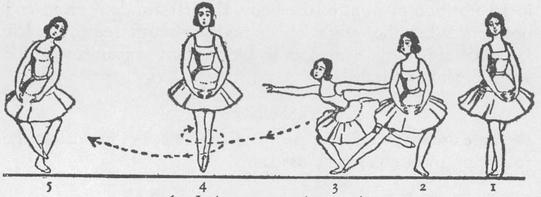
65. Jeté en tournant (par terre)
Usually this jeté is done a consecutive number of times.
JETÉ EN TOURNANT
Begin with the preparatory movement. Stand in 5th position, right foot front. Do a small sissonne tombée forward with the right foot to 4th position croisé into a demi-plié on the right foot; then bring the left foot close to the 5th back and transfer the weight of the body on to it in demi-plié. The right leg is thrown out forward at 90°, and it describes a circle in the air while the body is turned to the right. In turning, jump onto the right foot and fall into attitude croisée, not letting yourself be carried away by the momentum, and at the same time, not bending much to the right at the concluding attitude.
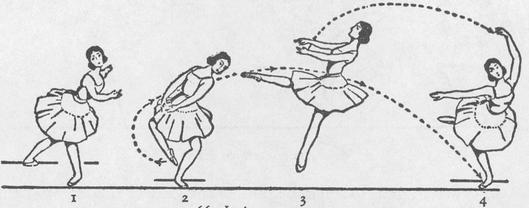
66. Jeté en tournant
In order to acquire force in the sissonne tombée, bend the body forward forcefully; in changing to the left foot, bend the body effacé and incline the head in the same direction, and from here describe an arc with the body.
During the preparatory sissonne tombée the right arm is bent in 1st position in front of the body, the left arm is open in 2nd position. When the weight of the body is transferred to the left leg in demi-plié, the arms join in 1st position to gain force. The arms finish in attitude.
22
SISSONNE
There are many different forms of sissonne. Let us analyse the following most commonly used.
SISSONNE SIMPLE
The elementary study of sissonne begins with its simplest form. 5th position, demi-plié, jump, during which the legs are joined, knees and toes extended, as in every jump. After the jump, lower yourself on one foot in demi-plié, the other foot sur le cou-de-pied, and finish with assemblé.
SISSONNE OUVERTE (OPEN)
Sissonne ouverte is a development of the foregoing movement, i.e. after the jump up, the leg, being carried through sur le cou-de-pied, opens in a pose at 45° to the side in the 2nd position, to the forward, or back.
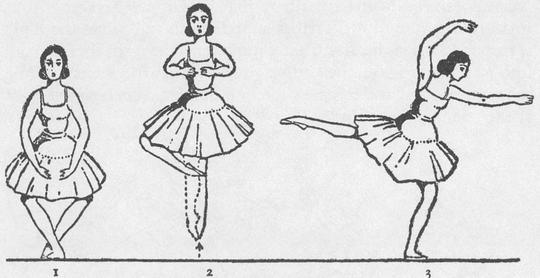
67. Sissonne ouverte en écarté at 90°
In order to gain balance, beginners may lower the leg after the jump and open it into 2nd position, front, or back with the toe on the floor.
The arms take the position corresponding to the ordered pose. In the advanced classes the jump is higher and stronger, and the leg is lifted to 90° in attitude, arabesque, écarté forward and back, etc. In perfecting sissonne ouverte you may do it flying to the side. If you do it forward, the pose will be attitude or arabesque back. When the jump is backwards, the raised leg will take the pose forward. For écarté, jump to the side, etc., depending on the direction of the required pose.
In the intermediate and advanced classes a more complicated form of sissonne ouverte en tournant is used. It is executed in the following manner: after demi-plié the right arm goes into 1st position, the left one into 2nd, and in this way force is taken for the turn in the air. One should pay attention that the right shoulder does not go forward before the jump. Push off with the heels, rise in the air, and doing a turn in the air, open the leg during the turn. Finish by stopping in the ordered pose at 45° or 90°.
